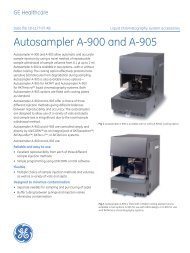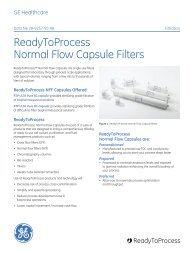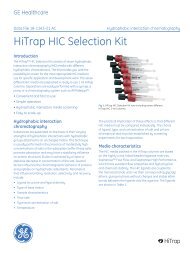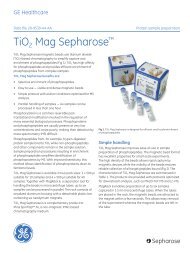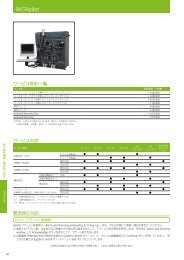[PDF] Ni Sepharose 6 Fast Flow
[PDF] Ni Sepharose 6 Fast Flow
[PDF] Ni Sepharose 6 Fast Flow
You also want an ePaper? Increase the reach of your titles
YUMPU automatically turns print PDFs into web optimized ePapers that Google loves.
Table 8. Amount of protein eluted after purification of GFP-(histidine) 6<br />
on<br />
<strong>Ni</strong> <strong>Sepharose</strong> 6 <strong>Fast</strong> <strong>Flow</strong>, His-Select, or <strong>Ni</strong>-NTA Superflow<br />
Medium<br />
The dynamic binding capacity of <strong>Ni</strong> <strong>Sepharose</strong> 6 <strong>Fast</strong> <strong>Flow</strong><br />
was also evaluated with pure MBP-(histidine) 6<br />
(M r<br />
43 000)<br />
using the parameter 10% breakthrough (Q B, 10%<br />
). Comparative<br />
chromatograms demonstrate that the dynamic binding<br />
capacity of <strong>Ni</strong> <strong>Sepharose</strong> 6 <strong>Fast</strong> <strong>Flow</strong> was 49 mg/ml medium,<br />
which greatly exceeded that of <strong>Ni</strong>-NTA Superflow (14 mg/ml<br />
medium, Fig 7).<br />
Column Column volume: volume: 0.25 ml, 0.25 (5 mm ml, (5 × mm 1.3 cm) × 1.3 cm)<br />
Media: Media: 1) <strong>Ni</strong> <strong>Sepharose</strong> 1) <strong>Ni</strong> <strong>Sepharose</strong> 6 <strong>Fast</strong> 6 <strong>Flow</strong>, <strong>Fast</strong> 2) <strong>Flow</strong>, <strong>Ni</strong>-NTA 2) <strong>Ni</strong>-NTA Superflow Superflow<br />
Sample: Sample: Pure histidine-tagged Pure histidine-tagged Maltose Maltose Binding Binding Protein, Protein, MBP-(histidine) 6<br />
,<br />
M MBP-(histidine) 6<br />
, M r 43 000, 1 mg/ml<br />
r<br />
43 000, 1 mg/ml<br />
Binding Binding buffer: buffer: 20 mM 20 sodium mM sodium phosphate, phosphate, 5 mM imidazole, 5 mM imidazole, 500 mM 500 NaCl, mM pH NaCl, 7.4<br />
pH 7.4<br />
Elution buffer: 20 mM sodium phosphate, 500 mM imidazole, 500 mM NaCl, pH 7.4<br />
Elution buffer: 20 mM sodium phosphate, 500 mM imidazole,<br />
<strong>Flow</strong> rate: 0.25 ml/min<br />
500 mM NaCl, pH 7.4<br />
<strong>Flow</strong> rate: 0.25 ml/min<br />
A)<br />
mAU<br />
Amount eluted protein (mg)<br />
<strong>Ni</strong> <strong>Sepharose</strong> 6 <strong>Fast</strong> <strong>Flow</strong> 40<br />
His-Select 25<br />
<strong>Ni</strong>-NTA Superflow 35<br />
High flow rates<br />
<strong>Ni</strong> <strong>Sepharose</strong> 6 <strong>Fast</strong> <strong>Flow</strong> provides high performance even<br />
at high flow rates. Figure 8 shows the purification of MBP-<br />
(histidine) 6<br />
in E. coli extract at three different flow rates (1, 2,<br />
and 4 ml/min; approx. 150, 300, and 600 cm/h, respectively)<br />
in a HisTrap FF 1 ml column. The results show minimal<br />
decrease in recovery and purity with increasing flow rate.<br />
The overall advantage of being able to increase flow rate<br />
is that the total time for protein purification is reduced<br />
considerably with a minimal loss in recovery (Table 9).<br />
Column: HisTrap FF 1 ml<br />
Column: Sample: HisTrap Histidine-tagged FF 1 ml Maltose Binding Protein in E. coli extract<br />
Sample: Binding buffer: Histidine-tagged 20 mM sodium Maltose phosphate, Binding Protein 25 mM in imidazole, E. coli extract<br />
Binding buffer: 20 mM 500 sodium mM NaCl, phosphate, pH 7.425 mM imidazole, 500 mM NaCl, pH 7.4<br />
Elution buffer: Elution buffer: 20 mM 20 sodium mM sodium phosphate, phosphate, 500 mM 500 imidazole, mM imidazole, 500 mM NaCl, pH 7.4<br />
<strong>Flow</strong> rates: 1, 2 and 500 4 ml/min mM NaCl, (approx. pH 7.4150, 300, and 600 cm/h, respectively)<br />
<strong>Flow</strong> rates: 1, 2 and 4 ml/min (approx. 150, 300, and 600 cm/h, respectively)<br />
A) mAU<br />
4000<br />
3000<br />
2000<br />
1000<br />
0<br />
1 ml/min<br />
2 ml/min<br />
4 ml/min<br />
0 10.0 20.0 30.0 40.0 min<br />
2000<br />
1500<br />
<strong>Ni</strong> <strong>Sepharose</strong> 6 <strong>Fast</strong> <strong>Flow</strong><br />
Binding capacity: 49 mg/ml medium<br />
B)<br />
M r<br />
97000<br />
1000<br />
66000<br />
B)<br />
500<br />
0<br />
mAU<br />
2000<br />
1500<br />
1000<br />
0 20.0 40.0 60.0 80.0 Column volumes<br />
(CV)<br />
<strong>Ni</strong>-NTA Superflow<br />
Binding capacity: 14 mg/ml medium<br />
45000<br />
30000<br />
20100<br />
14400<br />
1 2 3 4 5<br />
Lanes<br />
1. LMW markers<br />
2. Start material<br />
3. Eluted pool, 1 ml/min<br />
4. Eluted pool, 2 ml/min<br />
5. Eluted pool, 4 ml/min<br />
Fig 8. <strong>Ni</strong> <strong>Sepharose</strong> 6 <strong>Fast</strong> <strong>Flow</strong> provides high performance even at high<br />
flow rates. A) Purification of MBP-(histidine) 6<br />
in E. coli extract at three different<br />
flow rates. B) Eluted material analyzed by SDS-PAGE (ExcelGel SDS Gradient<br />
8–18), under nonreducing conditions, confirms that increasing flow rate<br />
does not significantly affect the recovery or purity of the purified material.<br />
500<br />
0<br />
0 20.0 40.0 60.0 80.0 Column volumes<br />
(CV)<br />
Fig 7. <strong>Ni</strong> <strong>Sepharose</strong> 6 <strong>Fast</strong> <strong>Flow</strong> has a greater dynamic binding capacity<br />
than <strong>Ni</strong>-NTA Superflow, measured as sample volume applied until 10%<br />
breakthrough for MBP-(histidine) 6<br />
. Note that the areas of the elution peaks<br />
cannot be compared since the highest absorbance signals are above the<br />
linear range.<br />
Table 9. Effects of different flow rates on total purification time and recovery<br />
<strong>Flow</strong> (ml/min) Time (min) Eluted protein (mg)<br />
1 48 5.4<br />
2 24 5.3<br />
4 12 5.2<br />
6 11-0008-86 AE


![[PDF] Ni Sepharose 6 Fast Flow](https://img.yumpu.com/21495109/6/500x640/pdf-ni-sepharose-6-fast-flow.jpg)
![[PDF] マニュアル GradiFrac](https://img.yumpu.com/22037825/1/190x253/pdf-gradifrac.jpg?quality=85)
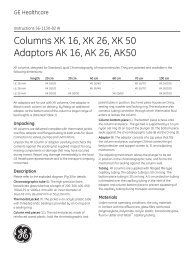
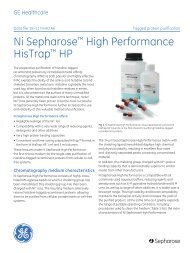
![[PDF] Sample preparation for analysis of protein, peptides and ...](https://img.yumpu.com/21549715/1/190x257/pdf-sample-preparation-for-analysis-of-protein-peptides-and-.jpg?quality=85)
![[PDF] Data File: rProtein A Sepharose Fast Flow](https://img.yumpu.com/21549316/1/190x253/pdf-data-file-rprotein-a-sepharose-fast-flow.jpg?quality=85)
![[PDF] MBP-tagged protein purification](https://img.yumpu.com/21548507/1/184x260/pdf-mbp-tagged-protein-purification.jpg?quality=85)
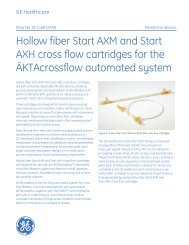
![[PDF] AKTA ready system Data file](https://img.yumpu.com/21540925/1/190x253/pdf-akta-ready-system-data-file.jpg?quality=85)
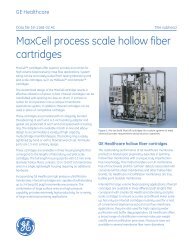
![[PDF] Data File - rProtein A/Protein G GraviTrap](https://img.yumpu.com/21539052/1/190x253/pdf-data-file-rprotein-a-protein-g-gravitrap.jpg?quality=85)
